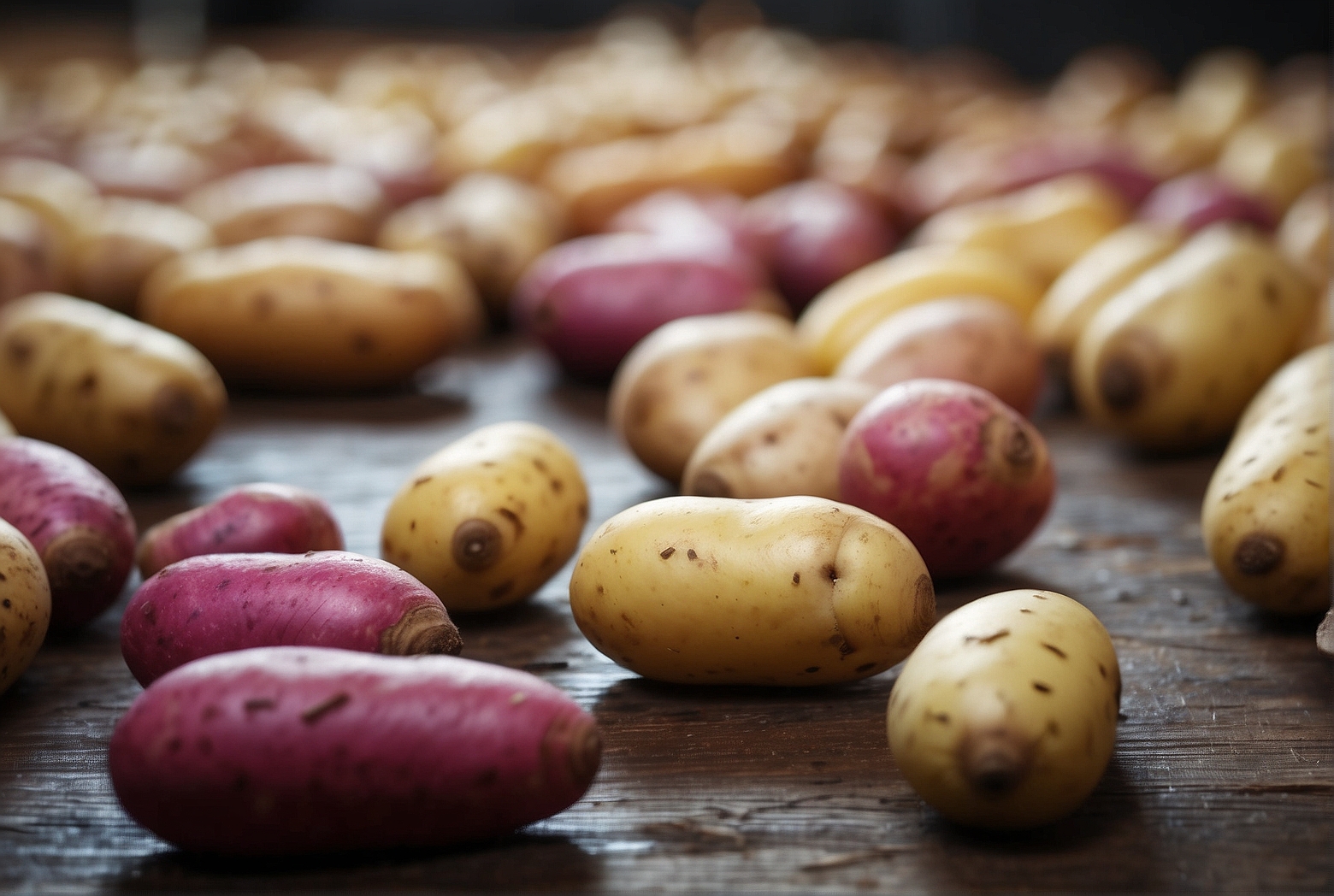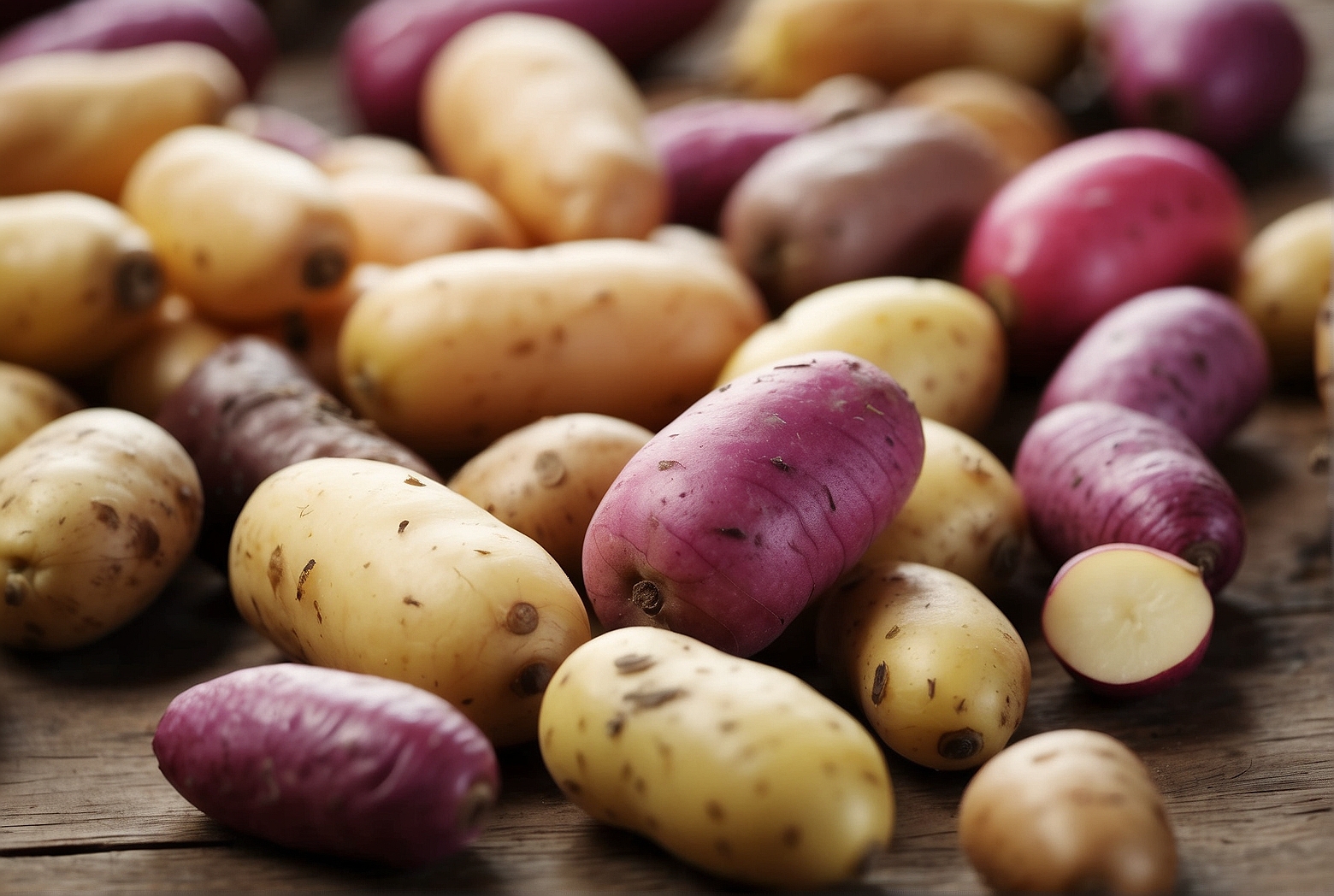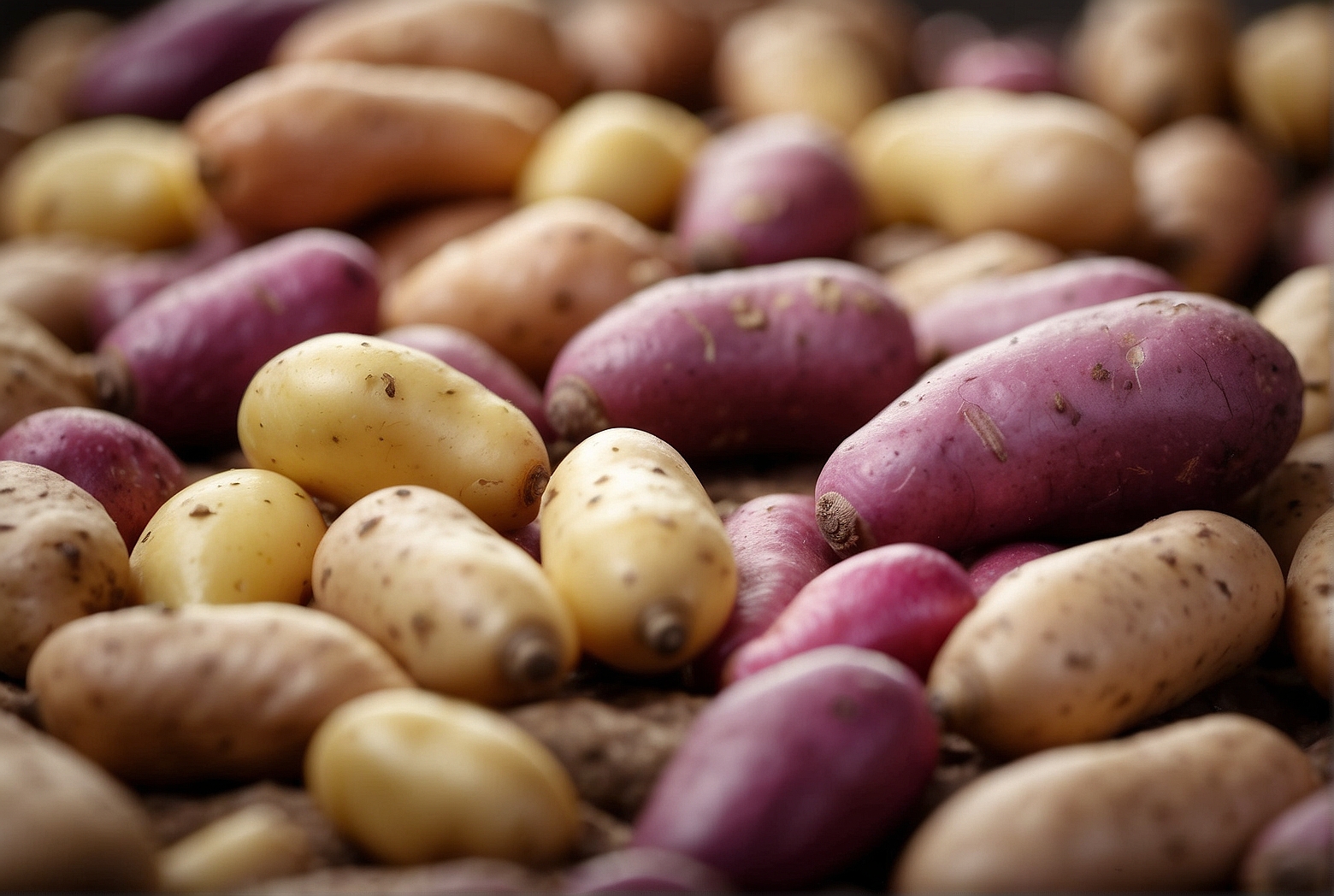Last Updated on April 2, 2024 by Tony Manhart
If you’ve ever wondered about the fascinating world of fingerling potatoes, chances are you’ve come across the terms “determinate” and “indeterminate.” But what exactly do these terms mean, and how do they relate to fingerling potatoes? In this article, we will explore the distinction between determinate and indeterminate potatoes, shedding light on whether or not fingerling potatoes fall into one category or the other. Get ready to unearth the secrets behind your favorite tuberous delicacy!
What are fingerling potatoes?
Definition
Fingerling potatoes are a type of small, elongated potato that resemble the shape of fingers. They are known for their unique appearance and delicious flavor. These potatoes are harvested before they reach their full maturity, resulting in a creamy texture and delicate taste.
Characteristics
Fingerling potatoes are typically small in size, ranging from two to four inches in length. They have a thin skin that can be either red, yellow, or purple. The flesh of fingerling potatoes is firm and waxy, making them perfect for various culinary uses. Their shape and creamy texture set them apart from other types of potatoes.
Culinary Uses
Fingerling potatoes are a versatile ingredient in the kitchen. Due to their delicate and buttery taste, they can be prepared in numerous ways. These potatoes are commonly roasted, boiled, steamed, or grilled. They can be added to salads, stews, soups, or used as a side dish. The unique shape and flavor of fingerling potatoes make them a popular choice among chefs and home cooks alike.

Differentiating determinate and indeterminate potatoes
Potato Types
Potatoes can be classified as either determinate or indeterminate based on their growth patterns. Determinate potatoes have a set growth period and stop producing tubers once they reach maturity. On the other hand, indeterminate potatoes continue to produce tubers throughout the growing season.
Plant Growth
Determinate potato plants have a compact growth habit, with their stems and foliage reaching a specific height before stopping. They have a more bush-like appearance and tend to require less space in the garden. Indeterminate potato plants, on the other hand, have a more vining growth habit, with their stems and foliage continuing to grow and spread throughout the season.
Yield
Determinate potatoes usually produce a higher yield per plant, as they focus their energy on producing a concentrated number of tubers during their limited growth period. Indeterminate potatoes, while they may produce fewer tubers per plant, have the advantage of continuous tuber production, leading to a potentially higher overall yield throughout the season.
Tubers
Determinate potatoes tend to have a more uniform size and shape in their tubers. These potatoes are often commercially preferred for their consistency in appearance and marketability. Indeterminate potatoes, on the other hand, can produce a wider variety of tuber shapes and sizes, resulting in a more diverse potato harvest.

Harvesting
Determinate potatoes are typically harvested all at once when they reach maturity, as their growth cycle is predetermined. Indeterminate potatoes can be harvested in stages, allowing for a longer harvesting period. This staggered harvest can be advantageous for those who prefer to have a continuous supply of fresh potatoes.
Storage
Determinate potatoes, due to their tendency to have a uniform size and shape, are often easier to store. Their more predictable growth and harvest time makes it simpler to manage storage conditions. Indeterminate potatoes, with their varied shapes and sizes, may require more careful storage considerations to ensure optimal quality and longevity.
Varieties of Fingerling Potatoes
Both determinate and indeterminate potato varieties can come in the fingerling form. Some popular fingerling potato varieties include Russian Banana, French Fingerling, Purple Peruvian, Austrian Crescent, and Pink Fir Apple. These varieties offer unique flavors and characteristics that make fingerling potatoes even more appealing to culinary enthusiasts.
Determinate potatoes
Definition
Determinate potatoes are a specific category of potatoes that cease tuber production once they reach maturity. These potatoes have a predetermined growth period and do not continue producing tubers throughout the season.
Characteristics
Determinate potatoes are characterized by their compact growth habit and limited stem and foliage growth. These potatoes have a defined height and stop growing once they reach maturity. They tend to have a more bush-like appearance and require less space in the garden compared to indeterminate potatoes.
Advantages
One of the advantages of growing determinate potatoes is their higher yield per plant. Since all tubers are produced within a specific time frame, the plants can channel their energy into developing a concentrated number of tubers. This can result in a greater harvest yield in a shorter period, making determinate potatoes appealing for those who desire a more efficient and timely harvest.
Indeterminate potatoes
Definition
Indeterminate potatoes are a specific category of potatoes that continue to produce tubers throughout the growing season. Unlike determinate potatoes, their tuber production does not cease once they reach maturity.
Characteristics
Indeterminate potatoes are characterized by their vining growth habit and continuous stem and foliage growth. These potatoes have a tendency to spread and require more space in the garden compared to determinate potatoes. Their growth is not limited to a specific height, allowing them to continue producing tubers throughout the season.
Advantages
One advantage of growing indeterminate potatoes is their potential for a longer harvesting period. Since they continue to produce tubers, they offer a continuous supply of fresh potatoes throughout the growing season. This can be advantageous for those who prefer a more prolonged harvest or desire a constant source of homegrown potatoes.
Comparison between determinate and indeterminate potatoes
Plant Growth
Determinate potatoes have a compact and bush-like growth habit, while indeterminate potatoes have a vining growth habit that spreads throughout the garden. The growth patterns of these two types of potatoes determine their overall appearance and the space they require.
Yield
Determinate potatoes tend to produce a higher yield per plant, as their energy is focused on producing tubers within a specific time frame. Indeterminate potatoes, while they may produce fewer tubers per plant, can have a greater overall yield throughout the season due to their continuous tuber production.
Tubers
Determinate potatoes often have more uniform-sized tubers and a consistent appearance, which can be advantageous for commercial purposes. Indeterminate potatoes, with their ability to produce tubers continuously, can result in a more diverse harvest with variations in shape and size.
Harvesting
Determinate potatoes are typically harvested all at once when they reach maturity, while indeterminate potatoes can be harvested in stages. The ability to stagger the harvest of indeterminate potatoes allows for a longer period of enjoying freshly harvested potatoes.
Storage
Determinate potatoes, with their more uniform size and shape, tend to be easier to store. Their predictable growth and harvest time make it simpler to manage storage conditions. Indeterminate potatoes may require more careful storage considerations due to their varied shapes and sizes.
Benefits of growing fingerling potatoes
Unique Flavor
Fingerling potatoes have a distinct and delicious flavor that sets them apart from other potato varieties. They offer a creamy and buttery taste that is often described as nutty or earthy. This unique flavor adds depth and complexity to various dishes, making fingerling potatoes a favorite among chefs and food enthusiasts.
Versatility in Cooking
Fingerling potatoes are extremely versatile in the kitchen. Their firm and waxy texture allows them to hold their shape well during cooking, making them suitable for a variety of cooking methods. Fingerling potatoes can be roasted, boiled, steamed, grilled, or even used in salads, stews, and soups. Their unique shape adds visual appeal to dishes, making them a popular choice for both home cooks and professional chefs.
Nutritional Value
Fingerling potatoes, like other potato varieties, provide essential nutrients and fiber. They are a good source of vitamin C, potassium, and vitamin B6, among other nutrients. The skins of fingerling potatoes contain additional dietary fiber and nutrients, so it is recommended to consume them with the skin intact. Incorporating fingerling potatoes into your diet can contribute to a well-rounded and nutritious meal.
Challenges in growing fingerling potatoes
Maintenance
Growing fingerling potatoes can present certain challenges in terms of maintenance. These potatoes require well-drained soil and consistent watering to ensure proper growth. Additionally, they may be more susceptible to diseases and pests, so regular monitoring and appropriate preventative measures should be taken to protect the plants.
Availability
Fingerling potatoes may not be as readily available in grocery stores compared to more common potato varieties. While they are gaining popularity, their availability can vary depending on the location and season. Therefore, growing fingerling potatoes at home can provide a more reliable and accessible supply.
Market Demand
While fingerling potatoes are appreciated for their unique flavor and versatility in cooking, the market demand for them may not be as high as for other potato varieties. This can affect their availability and potentially limit the number of consumers interested in purchasing or growing them. However, for those who appreciate the distinct qualities of fingerling potatoes, growing them can be a rewarding and worthwhile experience.
Popular fingerling potato varieties
Russian Banana
Russian Banana fingerling potatoes are known for their elongated shape and smooth yellow skin. They have a buttery and nutty flavor, making them a popular choice for roasting or boiling. The creamy texture of Russian Banana potatoes complements various dishes and adds a touch of elegance to any meal.
French Fingerling
French Fingerling potatoes have a distinctive appearance with a reddish-pink skin and creamy yellow flesh. They are prized for their complex and rich flavor, often described as earthy and nutty. French Fingerling potatoes are versatile in cooking and can be used in a wide range of culinary creations.
Purple Peruvian
As the name suggests, Purple Peruvian fingerling potatoes have a vibrant purple skin and a creamy white interior. They have a slightly sweet and nutty flavor and are often regarded as a gourmet choice. Their striking color adds visual appeal to dishes, making them a favorite among chefs and food enthusiasts.
Austrian Crescent
Austrian Crescent fingerling potatoes have a unique curved shape, resembling a crescent moon. They have a buttery and earthy flavor, with a texture that is both firm and creamy. Austrian Crescent potatoes are often used in salads, roasted, or grilled to showcase their distinct shape and delicious taste.
Pink Fir Apple
Pink Fir Apple fingerling potatoes are known for their elongated shape and thin, pale pinkish skin. They have a delicate and nutty flavor, with a firm and waxy texture. Pink Fir Apple potatoes are often boiled, steamed, or used in salads, allowing their unique shape to shine.
How to cook fingerling potatoes
Preparation
Before cooking fingerling potatoes, it is important to wash them thoroughly under running water to remove any dirt or debris. Depending on the recipe, you can choose to leave the skin intact or peel it off. If peeling, use a vegetable peeler and gently remove the skin, ensuring to leave as much flesh intact as possible. Once cleaned and peeled, fingerling potatoes can be cut into halves or left whole for cooking.
Cooking Methods
Fingerling potatoes can be cooked using various methods, depending on the desired texture and flavor. One popular method is roasting, which brings out the natural sweetness and crispness of the potatoes. To roast fingerling potatoes, toss them with olive oil, salt, and herbs of your choice, then spread them on a baking sheet and roast in a preheated oven until golden brown and tender.
Another common method is boiling, which yields soft and creamy fingerling potatoes. Bring a pot of salted water to a boil, add the potatoes, and cook until tender when pierced with a fork. Boiled fingerling potatoes can be used in salads, mashed, or served as a side dish.
Grilling is another delightful way to cook fingerling potatoes. Toss them with olive oil, salt, and spices, then grill them on a preheated grill until tender and slightly charred. Grilled fingerling potatoes add smoky flavors and a unique twist to your meals.
Serving Suggestions
Fingerling potatoes can be served in various ways depending on the dish and personal preference. They can be enjoyed simply seasoned with salt and pepper as a flavorful side dish. Alternatively, toss roasted or grilled fingerling potatoes with herbs, garlic, or lemon zest for an extra burst of flavor.
Fingerling potatoes are also a great addition to salads, whether served warm or cold. Combine them with other vegetables, herbs, and a tangy dressing for a refreshing and satisfying salad.
Lastly, fingerling potatoes can be mashed, adding a creamy and buttery element to the dish. Use a potato masher or a fork to mash the boiled potatoes, then season with salt, pepper, and ingredients like butter or cream for a smooth and delicious mashed potato dish.
Recipes
-
Roasted Garlic Parmesan Fingerling Potatoes: Toss halved fingerling potatoes with minced garlic, grated Parmesan cheese, olive oil, salt, and pepper. Roast in a preheated oven at 400°F (200°C) until golden brown and crispy.
-
Grilled Herbed Fingerling Potatoes: Toss whole fingerling potatoes with chopped fresh herbs (such as rosemary, thyme, and parsley), olive oil, salt, and pepper. Grill on a preheated grill for about 15-20 minutes, until tender and charred.
-
Warm Fingerling Potato Salad: Boil halved fingerling potatoes until tender. In a separate bowl, whisk together Dijon mustard, lemon juice, olive oil, salt, and pepper to make a dressing. Toss the cooked fingerling potatoes with the dressing, chopped green onions, and chopped parsley.
Conclusion
Fingerling potatoes offer a unique culinary experience with their distinctive shape, flavor, and versatility. Whether you choose determinate or indeterminate fingerling potato varieties, they can be a rewarding addition to your garden. From their unique buttery taste to their various cooking methods, fingerling potatoes bring a touch of elegance and deliciousness to any meal. So, why not try growing and cooking fingerling potatoes to enhance your culinary adventures? Enjoy the delightful flavors and numerous possibilities that these special spuds have to offer.
Tony Manhart is a passionate gardener who has been tending to gardens for over 20 years. He takes pride in creating beautiful outdoor spaces with plants, trees, and shrubs that can thrive in any environment. He loves to share his knowledge with others and has taught classes on gardening basics and advanced techniques. He is committed to sustainability, using natural and organic methods to create and maintain gardens. He also works with local organizations to create green spaces for communities. When he’s not gardening, Tony enjoys hiking, reading, and spending time with his family.


